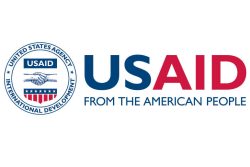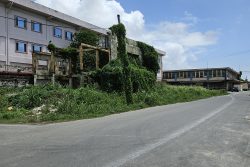– consultants
The consortium of consultants charged with determining the best design for the much debated Hope Conservancy Relief Channel has so far determined that the construction of a shallow outfall channel and a high crested weir (dam) would be the best option.

Yesterday, Chief Consultant for the project Raymond Latchmansingh handed over the draft of the final report to Agriculture Minister Robert Persaud. In March, the contract to provide consultancy services for the design of the channel was awarded to Cemco/ SRKN’gineering in association with the UK-based Mott MacDonald company. The contract had stipulated four months for the completion of this contract, but there was a delay owing to various factors, the chief consultant explained.
Latchmansingh said that during the period of study consultants came up with two designs that could be used for the relief channel. The second option is to construct a “Deep Outfall Channel and a Low invert sluice” at the location.
Speaking about the preferred option, Latchmansingh said the construction of the outfall channel and high crested weir would amount to approximately $3.6 billion. The system will have a discharge capacity of 62.1 cubic metres per second. This option, the consultant disclosed, proposes the construction of a high crested weir with 8 doors with 5 m wide radial gates as well as a weir crest elevation with 16 m GD. This design also proposes the construction of a 1km long outfall channel to the Atlantic Ocean with a 44.5 m bed and elevation of 15m GD. Latchmansingh also pointed out that investments would also have to make in terms of geotubes (shore-parallel geo-textile sleeves, which are sediment filled and which help to fight erosion) as well as in scour protection.
The other option for the construction of the deep outfall channel and the low invert sluice while being cheaper initially may prove more expensive in the long run, Latchmansingh stated. The initial cost of this option is estimated to be about $3.2 billion. The outline for this option proposes a “low level reinforced concrete outfall sluice with three 5 m gated openings as well as an “invert elevation of 14 m GD”. The construction of a 2.5 km long outfall channel to the Atlantic Ocean of 30 m bed width and elevation of 14 m GD has also been proposed. The discharge capacity of the system would be 66.0 cubic metres per second. However, Latchmansingh said, this option would require periodic dredging of the channel which would need special equipment and may prove to be extremely costly.
Quizzed as to the length of time each option would take, the chief consultant gave a timeline of three years for both projects.
Meanwhile, Latchmansingh further disclosed that the consultants are still awaiting the results of some tests conducted as part of the consultancy process. When these results arrive early next year, they will be added to the final report, he noted.
Head of SRKN’gineering Khrisna Narine said the softness of the soil along parts of the proposed channel was something that the consultants found to be problematic. Nevertheless, he explained that the consultants have come up with a plan which they feel would counteract this problem, hence the use of geotubes. He, however, stressed that rigorous testing would be imperative and urged the National Drainage and Irrigation Authority (NDIA) to be part of this process.
Meanwhile, Minister Persaud said that the draft report will now be rigorously scrutinized by the special technical team which comprises experienced and competent engineers. This team is working along with the NDIA on this project. Members of the team were present at the handing over of the document and raised preliminary questions concerning aspects of it, particular in relation to the use of geotubes and geo-textile materials.
According to Persaud, the project is an important one and consequently he did not push the consultants to work hastily since it was imperative that the consultation process be as thorough as possible. The minister said that the technical team will be examining the document and within the next three to four weeks they will be able to make a firm pronouncement as to the future of the project. However, he emphasized that as this point the ministry was giving “the green light” to this channel.
Persaud, meanwhile, told Stabroek News that this consultancy did not include a study of other options, but was done to determine the best technical option for the relief channel at Hope/Dochfour area. The minister has in the past repeated that the area was selected based on studies done by reputable international bodies. He said the purpose of the consultations would be to determine the best way to “tweak” the existing models that they had previously so that the greatest effectiveness could be achieved.
Ever since the plan for the relief channel was announced by the government, several engineers have openly questioned the wisdom of such a canal and have opined that cheaper and more effective options are available.
The proposed relief channel, which was initially priced at $3 billion, is intended to drain the East Demerara Water Conservancy (EDWC) into the Atlantic Ocean, thereby serving as a more efficient and less destructive means of releasing water from the conservancy. At the moment, when the EDWC is at a dangerous level, water from the conservancy is drained through the Maduni and Lama sluices and this has caused catastrophic flooding in the Mahaica and Mahaicony areas.









